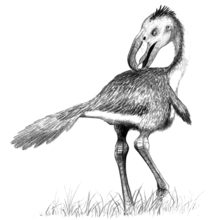Andalgalornis
| Andalgalornis Temporal range: Late Miocene - Early Pliocene | |
|---|---|
 | |
| CT scan of the skull of P 14357, holotype of Andalgalornis ferox in the collections of the Field Museum of Natural History | |
| Scientific classification | |
| Kingdom: | Animalia |
| Phylum: | Chordata |
| Class: | Aves |
| Order: | Cariamiformes |
| Family: | Phorusrhacidae |
| Genus: | Andalgalornis Patterson & Kraglievich, 1960 |
| Species: | A. steulleti |
| Binomial name | |
| Andalgalornis steulleti (Kraglievich, 1931) | |
| Synonyms | |
Kraglievich, 1931
Kraglievich, 1931
Patterson & Kraglievich, 1960
Kraglievich, 1931 | |
Andalgalornis was a genus of flightless predatory birds of the family Phorusrhacidae (often called "terror birds") that lived in Argentina. The type and only species is A. steulleti.
Andalgalornis is known from an incomplete skeleton and some single bones found from sites in the Entre Ríos and Catamarca Provinces of northeast and northwest Argentina. The fossils were uncovered from the Miocene to Early Pliocene Andalgala Formation.
Description

Andalgalornis stood around one and a half meters tall. The subfamily to which the genus belonged, the Patagornithinae, contained species that were of quite slender build; it looked much like the larger phorusrhacid Phorusrhacos, but it was more elegant and smaller and had a proportionally higher beak, the most massive in proportion to body size of all phorusrhacids. A recent analysis of CT scans of the skull of Andalgalornis suggests that the beak was strong dorsoventrally (in the vertical plane) but relatively weak mediolaterally on either side. The beak's weakness suggests that the bird could not have taken down large prey, but consumed smaller, more easily manageable and less risky prey. However, the beak's dorsoventral strength may have enabled Andalgalornis to quickly strike down on its prey in a repeated attack-and-retreat hunting strategy.[1]
A study of its neck vertebrae showed that they were built for striking.[2]
References
- ↑ Degrange, F.J.; Tambussi, C.P.; Moreno, K.; Witmer, L.M.; Wroe, S. (2010). "Mechanical Analysis of Feeding Behavior in the Extinct "Terror Bird" Andalgalornis steulleti (Gruiformes: Phorusrhacidae)". PLoS ONE 5 (8): e11856. doi:10.1371/journal.pone.0011856.g001. PMC 2923598. PMID 20805872.
- ↑ Tambussi, C. P.; De Mendoza, R.; Degrange, F. J.; Picasso, M. B. (2012). Evans, Alistair Robert, ed. "Flexibility along the Neck of the Neogene Terror Bird Andalgalornis steulleti (Aves Phorusrhacidae)". PLoS ONE 7 (5): e37701. doi:10.1371/journal.pone.0037701.
- Alvarenga, Herculano M. F. & Höfling, Elizabeth (2003): Systematic revision of the Phorusrhacidae (Aves: Ralliformes). Papéis Avulsos de Zoologia 43(4): 55-91 PDF fulltext
- Kraglievich, Lucas (1931): Contribución al conocimiento de las aves fósiles de la época araucoentrerriana. Physis 10: 304-315. [Article in Spanish]
- Patterson, B. & Kraglievich, Lucas (1960): Sistemática y nomenclatura de las aves fororracoideas del Plioceno Argentino. Publicacion del Museo Municipal Ciencias Naturales y Tradicionales de Mar del Plata 1: 1-51. [Article in Spanish]